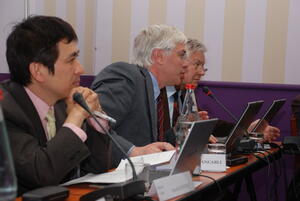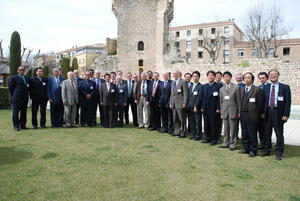Setting up the framework for ITER's test blanket program
Speaking in ITER language, no "port allocation" had been made to the meeting room in the Aquabella Hotel in Aix-en-Provence—no window to distract the attention of the government representatives and experts from the seven Members attending the first meeting of the ITER Council Test Blanket Module Program Committee last week. A historical meeting marking the program's official launch under the ITER umbrella.
It is stated among the technical objectives of ITER that "ITER should test tritium breeding module concepts that would lead in a future reactor to tritium self-sufficiency and to the extraction of high-grade heat and electricity production." In fact, ITER is a unique opportunity for testing mock-ups of breeding blankets, called test blanket modules (TBMs) in a real fusion environment.
The TBMs will test specific technologies that shall ensure tritium breeding self-sufficiency in the future—one of the major technological breakthroughs required for passing from ITER to the demonstration fusion power plant DEMO and finally to fusion power plants. ITER will gain the 10 kilograms of tritium necessary for its expected 20-year lifetime from external sources. But for DEMO, with an expected electrical power output of 800 MW, about 300g of tritium will be required per day. "As there is no sufficient external source of tritium for fusion energy development beyond ITER, the successful development of tritium breeding blankets is essential for the whole mission of fusion power," explains Luciano Giancarli, ITER Chief Technical Officer for the TBM program.
The goal of this first TBM Program Committee meeting was to define the governance of the TBM program—or how the ITER Organization and the seven Members will coordinate their work. "Nothing more, nothing less," as the panel's Chairman Satoshi Konishi, Professor at the Institute of Advanced Energy at Tokyo University, explained. Three ports within the ITER machine are allocated for testing the six trititum blanket technologies. Each port will be shared by two Members (or TBM partnerships) or, as in the case for Europe, one Member with two different technologies on the test stand. "We will certainly see some kind of conflict of interest along our way, but we will solve these conflicts," Konishi said. "This is part of our mission."
In what was commonly regarded as a "very good start to a long term exercise," the panel recommended a reference port allocation and the nomination of port masters and TBM leaders: port master for port number 16 will be Europe, which will be testing the concept of both the helium-cooled lithium lead and the He-cooled pebble beds (ceramic/beryllium). Port master for port number 18 will be Japan, which will be testing the concept of water-cooled ceramic breeder (+beryllium) and which will oversee the joint effort of US and Korea on testing the dual-coolant lithium-lead concept. Port 2 will finally be "mastered" by China, which will test He-cooled ceramic breeder (+beryllium) technology plus the technology of a lithium-lead ceramic breeder (LiPb & He, dual-coolant type) pursued by India. This is the recommendation the meeting will propose to the next ITER Council meeting in June this year.
The participants also agreed that appropriate persons acting as port masters and team leaders shall be nominated by 26 April. The second meeting of the Test Blanket Module Program Committee is scheduled for October this year.



